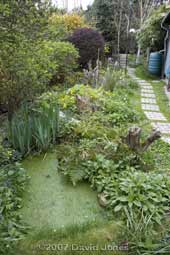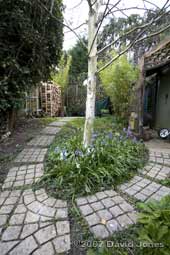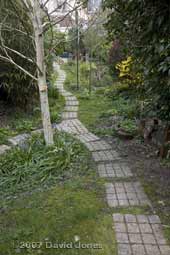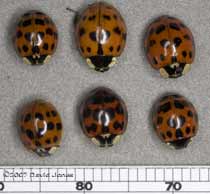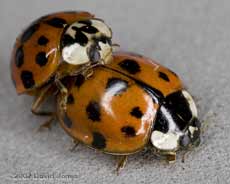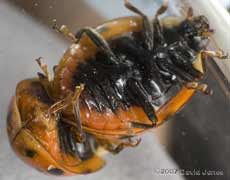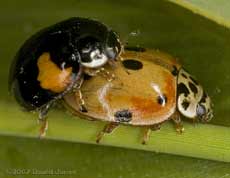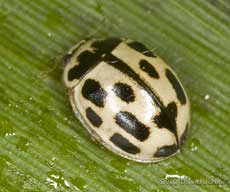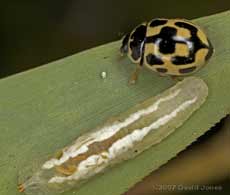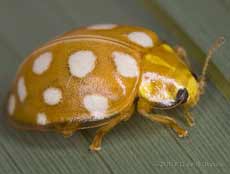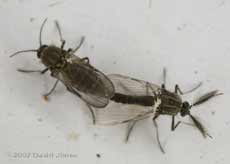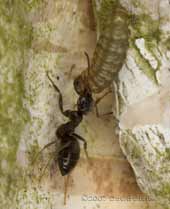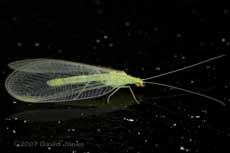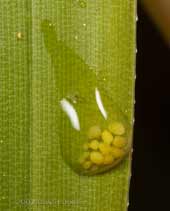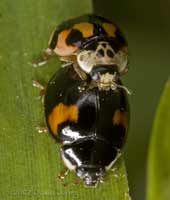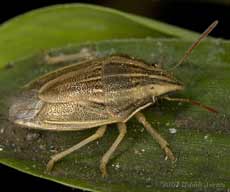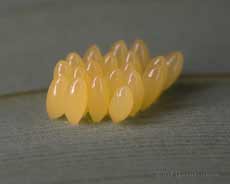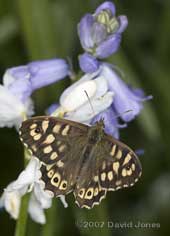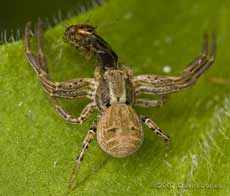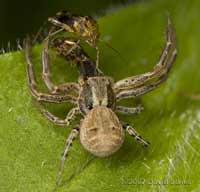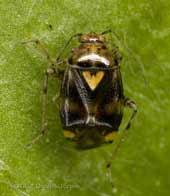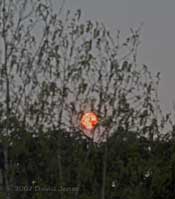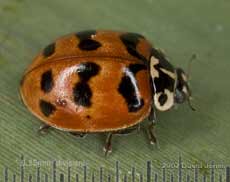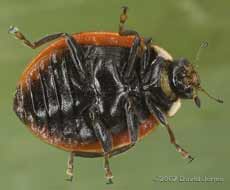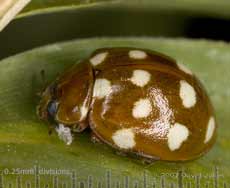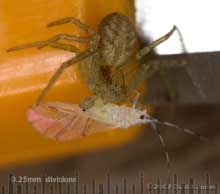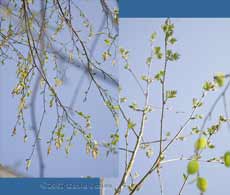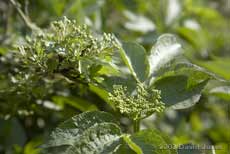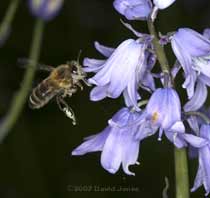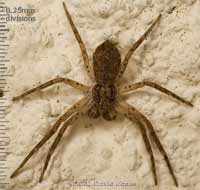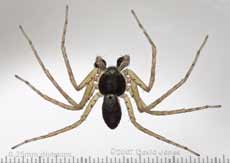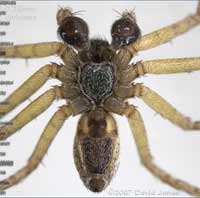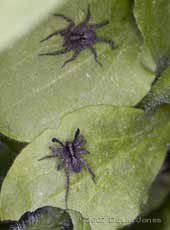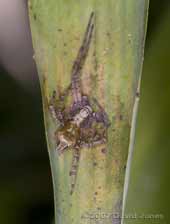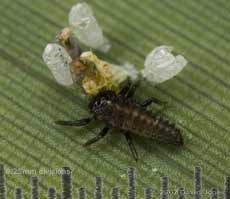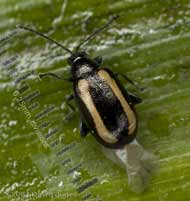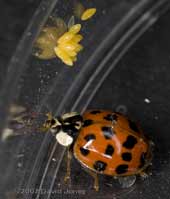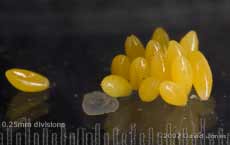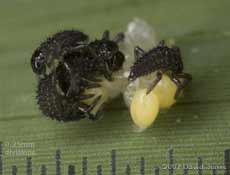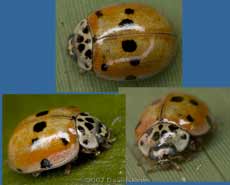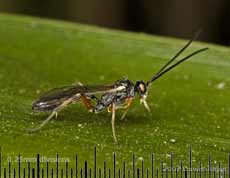Go to the last entry on this page .....Go to previous entry12 April - I've to stop and think what happened to the last five days! The weather has continued to give us an early taste of (almost) summer. The last three days have seen highs over 18C, and we have had several meals outside, but the cool breeze continues to remind us that it is only April. The day before yesterday we had a delivery of seasoned Oak for our log burner, ironically, on the first day that I've worn shorts this year! It arrived a few days early and I had to get on and make a log store for it down at the West Wing. At least we now have supplies ready for the Autumn, and there is space for fresh wood that my sons supply during the summer months. Before I start on the new photographs, I should mention the spider in the dandelion. The next morning I checked the flower - the spider had left it. In fact the flower didn't open and now I'm waiting for the seed head to be produced. I haven't seen the spider on any of the other flowers in the area around it.
The garden is now starting to thrive, with lush foliage developing everywhere. For those who haven't 'visited' the garden before, this is the view looking West over the small pond.
Walk down the path and just after the water butt you come to a divide in the path, where the Birch is surrounded by Bluebells at the moment. The right fork takes you to the Blue Tit box which is remaining empty at the moment, while the left-hand path goes up a short slope to the West Wing. You can see the new log store on the left, behind the Ivy tree.
Looking back from the West Wing, you can't help but notice that the slope either side of the path has lost nearly all of its grass cover, with the green colouring provided by moss instead. I'm not going to try to replace the grass, and have scattered meadow flower seeds over the area. Seeds that I spread a few weeks ago have already germinated, and today I scattered some more.
Today was definitely another ladybird day, and not all for the right reasons, so I'll start with the bad news.
While I can thank the breeze for bringing visitors to the garden, this morning it brought at least six Harlequin Ladybirds, all of which I caught on the higher foliage of the bamboo plants at the bottom of the garden.
As soon as I started putting them into a container, this pair met up and stayed together for over three hours.
For much of that time they were moving around the container at high speed, including hanging upside-down from the glass cover. They have now been killed in my freezer and kept so that I can show friends and neighbours what to watch out for.
It is disappointing to see the Harlequins at a time when our native species really are on the move.
Today I saw a couple of dozen 2-Spot Ladybirds, and at least eight 10-Spot Ladybirds like this mating pair - a melanic male and a faintly-spotted female.
There were also a number of 14-Spot Ladybirds, including one mating pair out of reach of the camera. This is a very pale spots free variant in amongst the drops of honeydew,
and this a darker, spots joined variant as it dashed past a hoverfly larva.
The final ladybird photograph of the day is of the second Orange Ladybird to make its appearance this year. It will be a while before the Birch foliage has mildew to offer these rather special (to me at least) ladybirds. Its buds have only just burst in the last two days. As is usual at this time of year, all the ladybirds were on the bamboo plants
There were two ladybird species that escaped my camera today - a couple of 7-Spot Ladybirds and the first Cream-spot Ladybird of the year.
This pair of mating midges landed next to my tools as I worked on the log store yesterday. The one with the feathery antennae and the thin abdomen is the male.
While I was on my ladybird hunt today, I also came across a Bishop's Mitre Bug again, but I didn't see any other large bugs, which was a bit of a surprise. Talking of bugs, last night I took my camera down the garden to try and photograph some very slender bugs that I'd seen on the trunk of the Birch. Unfortunately they were very sensitive to the light of my ringflash and kept dashing off before I could get near them.
However, this ant was too engrossed in its task to take much notice of me. It was about five feet up the tree, and was trying to drag a very reluctant grub down towards the ground.
The last couple of nights there have been quite a few Green Lacewings flying about in the garden, their fluttering showing up in the torch light. I must take some time to get some close-ups of these very delicate looking insects.
Finally a puzzle - I found this drip on a bamboo leaf. It contains what looks looks lumps of pollen. I couldn't see it later in the day, so I couldn't take a closer look.
And a couple bits more, that I shouldn't have forgotten - Two days ago I had a rare treat while I stood just beyond the far end of the big pond. A couple of Long-tailed Tits appeared in the border before going down to the water to bathe side by side, no more that 6 or 7 feet in front of me - fantastic! This afternoon I caught a just glimpse of a bird of prey flying quite high over us. It 's wings were the shape of a Kestrel type bird, not a Sparrowhawk, and certainly not a Buzzard (the only two birds of prey I have seen from here). I shall have to watch out for it again.
13 April - A day that started off overcast, but which became bright and sunny in the afternoon, with the temperature falling just short of 19C. Apart from one more Harlequin Ladybird ( same typical spotted pattern as yesterday's batch) luck stayed largely on our side today!
It seemed that the lack of morning sunshine reduced the ladybird numbers visible today, but I did manage to get a couple of pictures for the record when I found this pair of 10-spotted Ladybirds mating - the male is a chequered form while his partner is the melanic form.
And today I came across another Bishop's Mitre Shieldbug (Aelia acuminata). This is a very fresh looking individual, and I don't think it can be the same one that I saw in another part of the garden yesterday. Notice the small red spot above its compound eye. I think this is one of its simple eyes (ocelli) that are thought to measure light intensity. Perhaps they help insects detect a threat when a shadow passes over them suddenly - very often an insect that is in bright sunshine will dash off behind a leaf as soon as my camera creates a shadow over it.
A bit of great news from the bottom of the garden. Yesterday I was showing one of the Harlequin ladybirds to a neighbour, and in the course of conversation mentioned that I hadn't seen a Wren in the garden for a long time. Later on I spotted one going into the lower part of the Ivy tree, and today I can confirm that he is nest building in there. I stood and watched him taking several tufts of moss into the Ivy. I know that Wren males build several nests to tempt his mate, so I shall have to keep my fingers crossed that this nest is the chosen one! Finally, one of my sons turned up with a pile of Beech timber after giving a tree some essential attention this morning. Tomorrow I will need to prepare it for my log store - Beech needs seasoning so this will not be used until early next year.
14 April - If you didn't realise what the date was, it could have been the middle of Summer today as the temperature reached just over 22C on a cloudless day. We got that Beech timber stored away, with most of it cut and split, and in the next couple of days I need to complete the roof on the store before the weather decides to change. We need rain. I had to top up the pond again today. Surprisingly it was a quiet day for ladybirds with far fewer to be seen. Another Harlequin turned up.
I've marked the leaf stalk with a piece of wool so that I can go back and check on them.
I had been wondering why we haven't seen butterflies over the last few days, but today we had at least six species pass through - Large White, Small White, Brimstone, Holly Blue, a possible Peacock, and this Speckled Wood, the only one to stay around long enough for me to photograph.
Another spider photograph to day, of what I think is a Xysticus cristatus, one of the crab spiders. This one has caught a small bug, and continues to hold its predatory front legs in an ambush position.
As I watched it I was fascinated to see another bug approach the front of the spider several times, dodging its grasp each time. Sometimes it would go away and then return to repeat the action - strange! It was almost tempting to suggest that it was trying to get the spider to release the other bug!
After a couple of minutes I was distracted from the scene, and when I returned the spider had moved (still holding on to its prey) to another part of the Red Campion leaf. However, at the spot where I first photographed the spider was this bug which kept strangely still as I photographed it. It was dead. Could it have approached the spider once too often and been bitten, but left until later? Unfortunately I couldn't stay long enough to see if the spider returned for it. The bug looks like Liocoris tripustulatus and was 4mm long.
It seems that the Wren is an afternoon builder. After I watched it yesterday afternoon, today around 3.30pm, Sheila and I watched it collecting moss from the slope up to the West wing and carry it up into the Ivy.
The picture shows a hazy sun peeping through the Birch as it is about to disappear behind the conifers this evening.
The Harlequin Ladybirds continue to arrive, with seven caught yesterday, another two today, and yesterday this ladybird appeared which has caused me some head scratching. It doesn't match any of our native species, but is very small for a Harlequin, being just 5.5mm long. Also, I haven't seen any photographs of Harlequins with similar patterns on the wing cases.
This is an underside view of it. I'd appreciate any help on this one.
A lot easier to recognise, and much more welcome than the Harlequins, was this Cream-spot Ladybird on a bamboo plant on the West Wing. I have now found three clumps of ladybird eggs on the large-leafed bamboo by my workshop shed.
Another spider picture - this little spider was perched on a pair of scissors on the table on our veranda. I spotted it while we were having coffee, and it was only too happy to accept an aphid.
The trees in the garden are now starting to turn green as their leaves develop. On the left are the drooping branches of the Birch, and on the right the upright branches and divided leaves of the Rowan.
The Hawthorn is also turning green, and is absolutely covered with flower buds now, and as this picture shows, the Elder that grows next to it also has inflorescences of flower buds.
17 April - Yesterday the breeze swung round to the North, and today we felt its effect as the temperature only made it to 17C despite it being a sunny day. I spent much of the day taking advantage of the cooler temperatures to get on with stripping paint of more woodwork - we'll finally get the room finished soon! On advantage of that job was that once I applied the paint stripper I had to leave it alone for a while so I did get out into the garden at intervals through the day. The first thing to report is that I didn't find any Harlequin Ladybirds today. Mind you, the temperature drop must have affected our native ladybirds too as I found only a few of them today.
Anyway, it's good to see that local honey bees are finding their way to the garden, although they are outnumbered by the solitary bees at the moment.
Today's edition of the Daily Telegraph includes an item about the plight of Bumble Bees - The Bumblebee Conservation Trust is carrying out a survey of bumblebee distribution across the country. The article ends with a paragraph about not buying Spanish Bluebells. I'm afraid that it's one of those (or a hybrid) that the Honey bee is visiting in the picture above. I would love to replace all of those Bluebells in my garden with the native variety, but it would be difficult task to remove them all (especially with them established in neighbouring gardens), and native Bluebells that are available in our local garden centre are very expensive.
This individual paused on the wall of the house long enough for me to collect my camera and take a couple of pictures.
On the other hand, this spider was dashing about so fast that I needed to capture it for a short while. I believe that it is probably a male Philodromus dispar - the Latin name refers to the disparity in appearance between the male and the female.
The large palps are used to carry the spider's sperm (deposited on a small web and then draw up into reservoirs in the palps) as it searches for a mate.
Once it find a possible partner it is essential that the male makes exactly the right moves as any mistake could prove fatal, especially when it is smaller than the female! In this photograph the male, at the bottom of the picture, has found a female and is making the first attempts at signalling his intent by waving his palps in front of him. The female responded by waving her front legs quickly. Unfortunately, she couldn't have been too impressed by him as after a couple of minutes of displaying she simply walked away!
While courtship may be on the mind of many male spiders, other spiders are intent on catching their next meal. This spider spent at least a couple of hours in exactly the same position on a bamboo leaf waiting to ambush one of the many insects that visit to either sunbathe or feed on the honeydew. I couldn't help but think that it must have been quite deliberate in its positioning, so that it mimicked the brown lines of the leaf - I had to look twice to realise that it wasn't just a bit of debris on the leaf. A close look reveals that it has lost the second leg on its right side. The large palps indicate that this too is a male - the leg may have been lost to a predator, or during an attempt at mating.
The Wren was collecting moss and singing again this afternoon. We saw a pair of Robins for the first time since the nest was abandoned, and watched the male feed his partner (courtship feeding) in the Hawthorn.
18 April - As we head back into Spring the temperature didn't make it to 16C today despite more sunshine than yesterday. Last night it dipped to about 5C and it is forecast to drop to zero by midnight tonight. Today I managed to complete the paint stripping today and most of the woodwork has been primed. That job will be completed and the whole lot given a final coat tomorrow. Then it's the ceiling and walls to get their final coats of paint before the Starling eggs hatch! The work meant just a couple of garden breaks today - no Harlequins again, and just a couple of photographs. I wonder if all the Harlequin Ladybirds came from the same breeding site.
The number of native ladybirds visible in the garden was low again today, although it was still possible to find 2-Spot Ladybirds mating, and having photographed some eggs two days ago, this afternoon I spotted a newly hatched larva for the first time this year. Not surprisingly, this one looks like the larva of a 2-Spot Ladybird. Out of a group of five empty egg cases this was the only larva on the bamboo leaf.
The only other picture taken today was this tiny flea beetle. I thought it was probably a Turnip Flea (Phyllotreta nemorum), although the illustration in my insect guide suggests that the Turnip Flea has lighter legs - Philippe Moniotte (from Belgium) has e-mailed me to say that with its dark legs it is more likely to be Phyllotreta undulata.
There was more courtship feeding of the female Robin this afternoon, and the pair seemed very interested in the area behind the Ivy tree again. The abandoned eggs are still in the nestbox so I assume that they are considering another site in the ivy. If they do nest there it could mean we have three nests active in it, although the Blackbirds' nest was attacked by a Magpie at the end of the afternoon. The female Blackbird went back to the nest immediately afterwards, but I shall have to watch out to see if she is continuing to use it, or needs to start building all over again (this is her third nest so far this Spring). During the attack, both birds made a lot of noise and very cautiously tried to mob the Magpie when it perched in a conifer. Within minutes of the intruder leaving, the male Blackbird was back in his usual high perch, singing as though nothing had happened. It seems a strange strategy to advertise the site of your nest so loudly when it is so vulnerable to raids by predators. The Wren once again appeared in the late afternoon, singing loudly and taking some moss into its nest site. It seems that the Swifts are making an early return this year, with some sightings in this bit of the country, so I shall have to watch out for them (and monitor the nestbox cameras regularly from now on). The Springwatch survey also reveals that Hawthorns are already flowering in this area. Our tree hasn't quite got to that stage, but I don't think it will be long before the buds start opening. I followed a Tawny bumblebee around the garden today - it visited just the Violets and the White Dead Nettles. I also saw a completely black bumble bee, a very unusual sight here.
19 April - The forecast got things wrong for last night as the temperature bottomed out at 4C - today it reached just over 19C this afternoon. After yesterday's work today was one of those weary days. I did only a bit of the painting that I had intended to do, and unfortunately it meant that I didn't do much with my camera either.
The adults usually end up in my freezer so that I have examples to show to friends and neighbours in order to spread the word about them. However, these eggs will be kept and checked each day so that I can get pictures of the newly hatched larvae for ID purposes in the future.
The eggs themselves measure around 1.3 - 1.4mm in length and seem to be more or less featureless.
On the 14th I photographed what I suspected were 2-Spot Ladybird eggs on a bamboo leaf. This evening they are hatching out. These eggs, although similar in shape, were paler in colour, and smaller than the Harlequin eggs.
The larva that I photographed last night is still on the same leaf tonight, and I can see no sign of any of its siblings on that or the surrounding leaves.
Staying with ladybirds, this is a 10-Spot Ladybird with a near to typical spot pattern - rather unusual in the garden so far this Spring!
Well, after yesterday's visit from the Magpie, it seems that the female Blackbird is still going into the Ivy, although some major 'digging' at the side of the big pond suggests that she is either repairing the nest or replacing it. And the Wren continues to appear in the late afternoon. Today I saw it going in and out of the Ivy nest site at around 6.20pm. I had a fleeting glimpse of a Woodpecker today. Standing by the pond, I happened to look up and it was heading straight towards me (or at least, the tall peanut feeder), with its red under-tail patch clearly visible. Unfortunately it must have seen me and veered away. I retreated back to the house but it didn't return. I must put a fresh lot of peanuts in the feeder ready for its next visit.
Finally, another of the various ichneumon flies that appear on the bamboo plants. This one will stay unidentified for the moment at least. Click on images to see larger versions |
|
